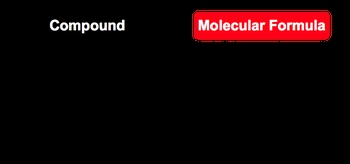Everyone, in this video, we're going to calculate the molecular formula. Now, once the empirical formula is determined, the molecular formula can be obtained if the molar mass is also known. Here in this example question, it says Ibuprofen, which has a molar mass of 206.3 grams per mole, works by reducing the production of prostaglandins. This is the chemical component responsible for pain. Now, if its percent composition is 75.70% Carbon, 8.80% Hydrogen, and 15.50% Oxygen, determine its molecular formula. Alright, step 1 here is just us repeating the steps necessary to determine the empirical formula of the compound.
Now, remember the step is we're going to use our element symbols. We're dealing with Carbon (C), Hydrogen (H), Oxygen (O). We're going to assume we're dealing with 100 grams of our compound, so each one of these percentages can be changed into grams. So we're going to have here 75.70 grams, we're going to have here 8.80 grams, and then 15.50 grams. Now that I have each of their grams, I'm going to change them into moles. And remember, we do this by dividing them by their atomic masses, which we find in the periodic table, and then 1 mole of oxygen is 16 grams. Here, the grams would cancel out. And remember, to avoid rounding errors, we make sure that we have at least 4 decimal places for each one of the mole totals. So when we plug this in, we're going to get 6.3031 moles of carbon, 8.7302 moles of hydrogen, and 0.9688 moles of oxygen.
Next, we divide all our mole totals by the smallest mole answer. The smallest mole out of these is 0.9688. So all of them are going to get divided by that number. This is going to give us 1 oxygen, 9 hydrogen, and 6.5 carbon. Now remember, we need to have a 0.1 or 0.9 in order to round. Here it's 6.5 so we can't round. That means we need to multiply this by a number to make it a whole number. We have to multiply this by 2. And if I multiply my Carbon by 2, I'd have to multiply the Hydrogen by 2 and the Oxygen by 2. So that's going to give me 13 carbons, 18 hydrogens, 2 oxygens. That together would give me my empirical formula, which is C13H18O2. Alright, so we've determined what our empirical formula is, and just to match things up, it's C13H18O2.
Alright, we've done all of step 1 so far. Step 2. We now need to calculate the empirical mass of the compound. Now, your empirical mass comes from the empirical formula. So we have 13 carbons, actually 18 hydrogens and 2 oxygens. Multiply them each by their atomic masses from the periodic table. When we do that, we're going to get 156.13 grams carbon, 18.144 grams hydrogen, and 32 grams oxygen. Add them all up together, that gives us 206.274 grams per mole. So this is the empirical mass of our empirical formula.
Now, step 3. We divide the molar mass, which was given to us in the very beginning of the question of the molecular formula, by the empirical mass to determine our n factor. So here we're going to say n equals our molar mass, which again was given to us in the very beginning divided by our empirical mass, which I'll just abbreviate as EM. So if we look at the very beginning of the question, they tell us that our molar mass of Ibuprofen is 206.3 grams per mole. We just calculated the empirical mass as 206.274 grams per mole. So here, n equals just 1. Alright.
So now what do I do with this n factor? Well, we come down to step 4 here. We're going to say we multiply the subscripts of the empirical formula by the n factor to get the molecular formula. So basically what I'm saying here is that we're going to say that n times your empirical formula equals your molecular formula. Okay. So we're going to say n is 1 times my empirical formula, which again was C13H18O2. So that gives me C13H18O2 as my molecular formula. This would be our final answer. We see here that sometimes your empirical formula and your molecular formula are the same. This happens anytime n is equal to 1. But there will be instances where you find your n factor and it'll be another number like 2 or 3, you'll multiply your empirical formula by that new n factor, and you'll see that in those cases your empirical formula and your molecular formula don't match. It just happens to be in this particular question, our empirical formula and molecular formula are the same.


